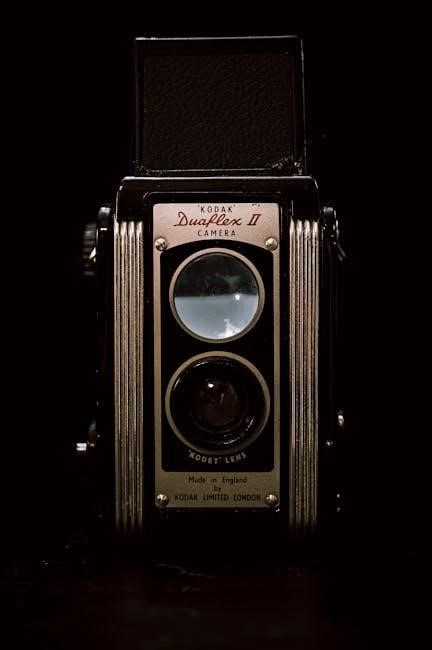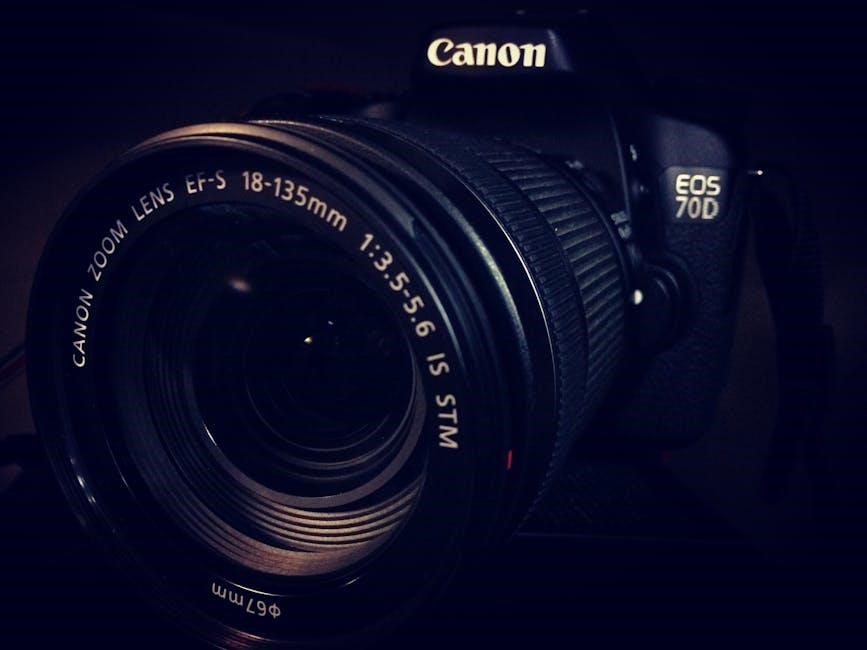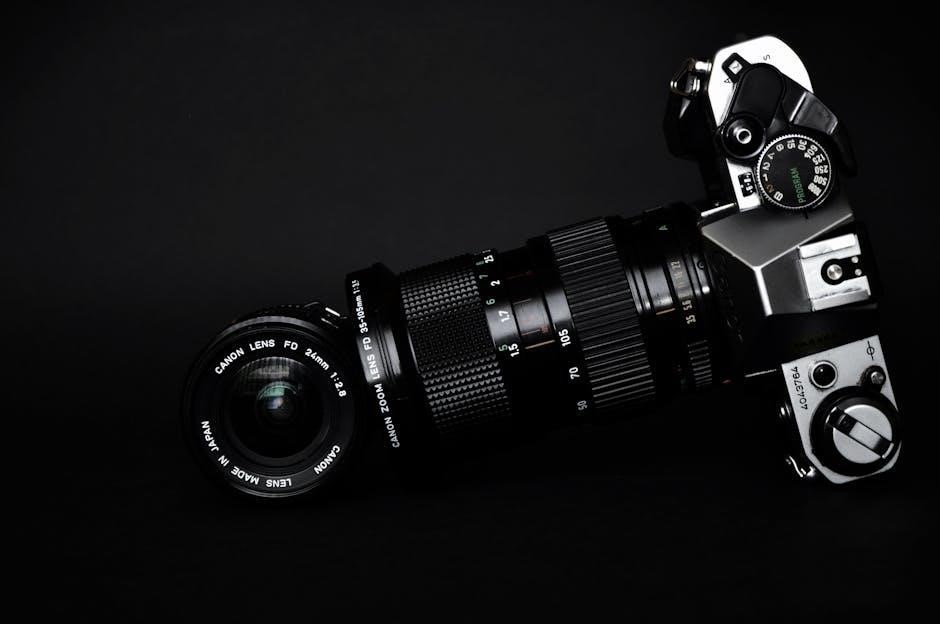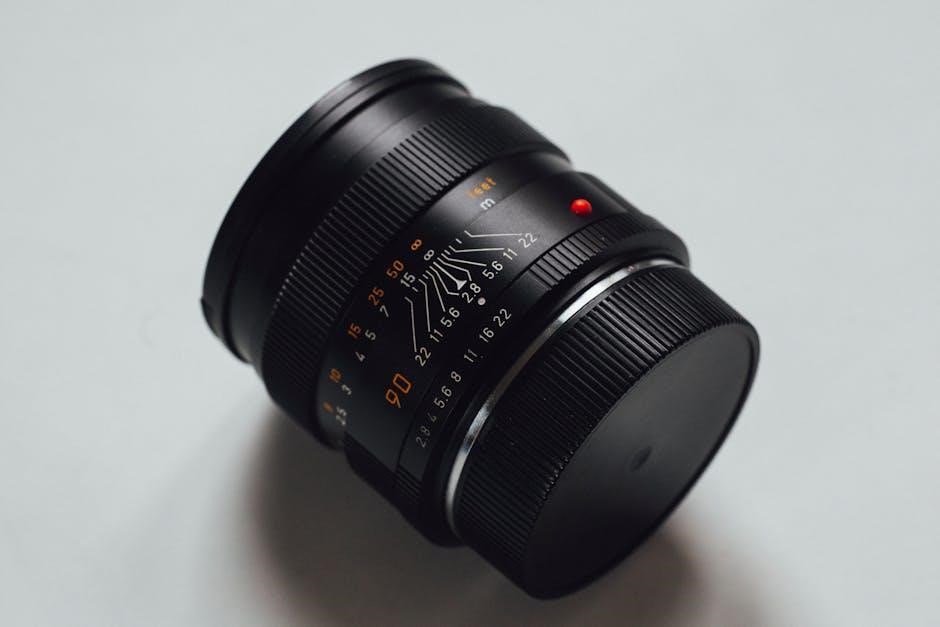The Tasco Trail Camera is a versatile digital scouting tool designed for capturing high-quality images and videos․ It features a PIR sensor for motion detection‚ ensuring clear photos even in low-light conditions with its built-in IR flash․ Perfect for wildlife monitoring or surveillance․
Overview of the Tasco Trail Camera
The Tasco Trail Camera is a reliable‚ motion-activated device designed for wildlife monitoring and surveillance․ Available in models like the 119270CW and 119271CW‚ it features a PIR sensor‚ IR LEDs for night vision‚ and multiple capture modes․ Its robust design and user-friendly interface make it ideal for outdoor use‚ capturing high-quality photos or videos in various environments‚ from forests to backyards․
Key Features and Benefits
The Tasco Trail Camera offers high-resolution imaging (6MP or 8MP) and 720p video recording with 10-second clips․ Its PIR motion sensor provides quick and accurate detection․ The camera operates in standby mode with low power consumption (<0․5mA)‚ ensuring extended battery life․ It supports SD/SDHC cards and features multiple capture modes for flexibility․ The built-in IR LEDs enable night vision‚ making it effective for 24/7 surveillance in various lighting conditions․

Mounting the Tasco Trail Camera
The Tasco Trail Camera can be securely mounted using the adjustable web belt or the tripod socket‚ offering flexibility for various setups and ensuring stable positioning․
Using the Adjustable Web Belt
Mounting the Tasco Trail Camera using the adjustable web belt is straightforward․ Thread one end of the belt through the camera’s back brackets and secure it with the buckle․ This method allows easy installation on trees or poles‚ providing a sturdy and adjustable setup for optimal camera positioning in the field․
Using the Tripod Socket
The tripod socket offers a stable and flexible mounting option for the Tasco Trail Camera․ Simply attach the camera to a tripod using the socket located at the base․ This method is ideal for stationary setups‚ ensuring minimal movement and vibration‚ which is crucial for clear image and video capture․ It provides a reliable alternative to the web belt for scenarios requiring precise positioning․

Understanding the PIR Sensor
The PIR sensor detects heat changes‚ triggering the camera to capture images or videos when motion is detected․ It’s essential for reliable wildlife monitoring and surveillance․
How the Passive Infra-Red (PIR) Sensor Works
The PIR sensor detects infrared energy emitted by objects‚ particularly heat from moving animals․ It monitors changes in the surrounding infrared levels within its 30-degree detection zone․ When a significant change is detected‚ the sensor triggers the camera to capture images or videos‚ ensuring efficient motion detection for wildlife monitoring and surveillance applications․
PIR Detection Zone and Field of View
The Tasco Trail Camera’s PIR sensor operates within a 30-degree cone-shaped detection zone at the center of the camera’s field of view․ This zone senses infrared energy changes‚ triggering image or video capture when movement is detected․ The sensor establishes an average infrared level‚ ensuring accurate detection of moving objects within its range‚ making it effective for monitoring wildlife or surveillance applications․

Image and Video Capture Settings
The Tasco Trail Camera captures high-quality still images at 6MP or 8MP resolution and records 720p video clips up to 10 seconds long‚ ensuring clear wildlife documentation․
Photo Resolution Options (6MP or 8MP)
The Tasco Trail Camera offers two photo resolution settings: 6MP and 8MP․ The 6MP setting is ideal for capturing clear images of wildlife while conserving storage space․ Meanwhile‚ the 8MP option provides higher detail‚ making it suitable for users who prioritize image quality․ Both settings ensure vibrant colors during the day and sharp black-and-white images at night‚ thanks to the infrared LEDs․
Video Clip Settings (720p‚ 10 Seconds)
The Tasco Trail Camera records video clips in 720p resolution with a fixed duration of 10 seconds per clip․ This setting ensures high-quality video capture while managing file sizes for storage efficiency․ The camera automatically triggers video recording upon motion detection‚ providing a clear and concise visual record of wildlife activity․ The infrared LEDs also support nighttime video capture‚ ensuring visibility even in low-light conditions․

Battery Life and Power Consumption
The Tasco Trail Camera consumes minimal power in standby mode (<0․5mA)‚ offering up to six months of operation with alkaline batteries and twelve months with lithium batteries․
Standby Power Consumption (<0․5mA)
The Tasco Trail Camera’s standby power consumption is remarkably low‚ at less than 0․5mA․ This energy-efficient design ensures extended operation‚ making it ideal for remote or long-term surveillance․ The low power draw helps maximize battery life‚ allowing the camera to remain active for months without frequent battery replacements․ This feature is particularly beneficial for wildlife monitoring in areas where access is limited․
Battery Life Estimates (Alkaline vs․ Lithium)
The Tasco Trail Camera offers extended battery life‚ with estimates varying by battery type․ Using eight AA alkaline batteries‚ it can operate for up to six months on standby‚ capturing about 30 images daily․ Lithium batteries extend this to twelve months under the same conditions‚ making them the preferred choice for longer-lasting performance in the field․

Setting Up the Camera

Set up the Tasco Trail Camera by navigating through the menu using the UP and DOWN keys․ Set the time‚ date‚ and select capture modes to begin operation․
Setting Time and Date
Access the Tasco Trail Camera’s menu using the UP and DOWN keys․ Navigate to the time and date section‚ select it‚ and input the current date and time using the arrow keys․ Ensure accuracy for proper photo timestamps․ Save your settings and exit the menu․ Verify by capturing a test photo to confirm the timestamp displays correctly․ If issues arise‚ check battery levels or format the SD card for optimal performance․
Selecting Capture Modes (Single Photo‚ Rapid Sequence‚ Video)
Choose between three capture modes using the Tasco Trail Camera’s menu․ Select Single Photo for a single image per trigger‚ Rapid Sequence for three quick photos‚ or Video for a 10-second clip․ Navigate with the UP/DOWN keys and confirm with the SELECT button․ Ensure sufficient memory card space for your chosen mode․ Refer to the manual for additional guidance on optimizing settings for your specific needs․

Storage and Memory
The Tasco Trail Camera supports SD and SDHC cards for storing images and videos․ Use a high-quality card with sufficient capacity to ensure optimal performance and reliability․
SD Card Recommendations and Compatibility
The Tasco Trail Camera supports SD and SDHC memory cards for secure storage of images and videos․ For optimal performance‚ use high-quality cards with capacities up to 32GB․ SanDisk SD cards are recommended for reliability and compatibility․ Ensure the card is formatted correctly before use to prevent errors and maintain functionality․ Always choose cards with sufficient storage to avoid running out of space during extended use․
Formatting the SD Card for Optimal Performance
Formatting the SD card ensures proper function and prevents errors․ Use the camera’s setup mode to format the card‚ as external formatting may cause issues․ Access the menu‚ navigate to the format option‚ and confirm․ This process erases all data‚ so ensure backups are made․ Regular formatting maintains performance and compatibility‚ guaranteeing reliable image and video storage․ Always format in the camera‚ not on a computer‚ for best results;

Troubleshooting Common Issues
Check connections for loose wires or faulty sensors․ Clean the lens and PIR sensor regularly․ Ensure SD cards are properly formatted and compatible․ Restart the camera if unresponsive․
Resolving Connection Problems
Check for loose or corroded connections‚ especially the SD card slot and battery compartment․ Clean contacts with a soft cloth or pencil eraser․ Ensure the SD card is properly formatted and compatible․ Verify battery installation and power levels․ Restart the camera after resolving any issues․ If problems persist‚ consult the user manual or contact support for further assistance․
Fixing Image Readability Issues
If images appear blurry or corrupted‚ ensure the SD card is compatible and properly formatted․ Clean the camera lens with a soft cloth to remove dirt or moisture․ Check battery levels‚ as low power can affect image quality․ Verify that the camera settings‚ such as resolution and video mode‚ are correctly configured․ If issues persist‚ reset the camera or update its firmware for optimal performance․

Maintenance and Care
Regularly clean the camera lens and exterior with a soft cloth to ensure optimal performance․ Check and replace batteries as needed to maintain reliability and image quality․
Cleaning the Camera and Lens
Regular cleaning is essential for maintaining image quality․ Use a soft‚ dry cloth to wipe the camera’s exterior and lens․ For tougher smudges‚ lightly dampen the cloth with water‚ but avoid harsh chemicals․ Gently rub the lens in a circular motion to remove dirt or smudges․ Never touch the lens surface with your fingers‚ as oils can leave residue․ Cleaning ensures clear photos and optimal performance in all conditions․
Checking and Replacing Batteries
Ensure the camera is turned off before handling the batteries․ Locate the battery compartment‚ usually on the bottom or rear‚ and remove it․ Check battery levels by inspecting for corrosion or dimming․ Replace batteries with the recommended type (Energizer Lithium AA for maximum life)․ Avoid mixing old and new batteries or using rechargeables unless specified․ Dispose of old batteries safely and follow proper recycling guidelines․ Regular checks ensure reliable performance and image capture․
Final Tips for Using Your Tasco Trail Camera
To optimize your Tasco Trail Camera’s performance‚ ensure proper positioning for best coverage․ Use lithium batteries for extended life and always format SD cards before use․ Regularly clean the lens and check settings like date‚ time‚ and capture modes․ Avoid mixing old and new batteries‚ and store the camera in a dry‚ cool place when not in use for longevity․
Resources for Further Assistance
For detailed guidance‚ refer to the Tasco Trail Camera manual‚ available online as a PDF․ Additional support can be found on Tasco’s official website‚ which offers user manuals‚ troubleshooting guides‚ and FAQs․ For video tutorials and setup tips‚ visit the Tasco YouTube channel or authorized retailer sites․ Contact customer support for personalized assistance with any model-specific queries or issues․
